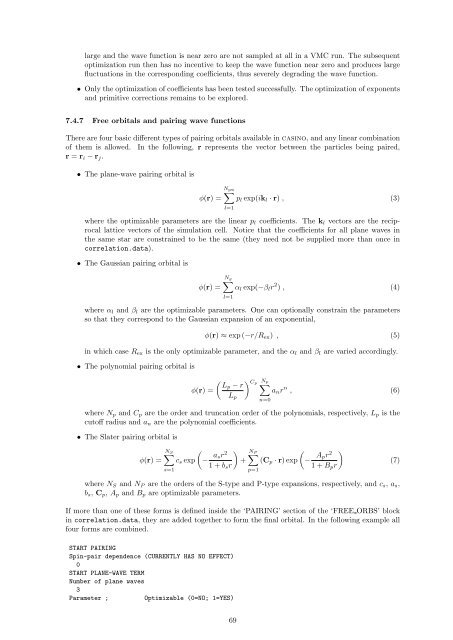CASINO manual - Theory of Condensed Matter
CASINO manual - Theory of Condensed Matter
CASINO manual - Theory of Condensed Matter
You also want an ePaper? Increase the reach of your titles
YUMPU automatically turns print PDFs into web optimized ePapers that Google loves.
large and the wave function is near zero are not sampled at all in a VMC run. The subsequent<br />
optimization run then has no incentive to keep the wave function near zero and produces large<br />
fluctuations in the corresponding coefficients, thus severely degrading the wave function.<br />
• Only the optimization <strong>of</strong> coefficients has been tested successfully. The optimization <strong>of</strong> exponents<br />
and primitive corrections remains to be explored.<br />
7.4.7 Free orbitals and pairing wave functions<br />
There are four basic different types <strong>of</strong> pairing orbitals available in casino, and any linear combination<br />
<strong>of</strong> them is allowed. In the following, r represents the vector between the particles being paired,<br />
r = r i − r j .<br />
• The plane-wave pairing orbital is<br />
N pw<br />
∑<br />
φ(r) = p l exp(ik l · r) , (3)<br />
l=1<br />
where the optimizable parameters are the linear p l coefficients. The k l vectors are the reciprocal<br />
lattice vectors <strong>of</strong> the simulation cell. Notice that the coefficients for all plane waves in<br />
the same star are constrained to be the same (they need not be supplied more than once in<br />
correlation.data).<br />
• The Gaussian pairing orbital is<br />
N g<br />
∑<br />
φ(r) = α l exp(−β l r 2 ) , (4)<br />
l=1<br />
where α l and β l are the optimizable parameters. One can optionally constrain the parameters<br />
so that they correspond to the Gaussian expansion <strong>of</strong> an exponential,<br />
φ(r) ≈ exp (−r/R ex ) , (5)<br />
in which case R ex is the only optimizable parameter, and the α l and β l are varied accordingly.<br />
• The polynomial pairing orbital is<br />
( ) Cp N<br />
Lp − r ∑ p<br />
φ(r) =<br />
a n r n , (6)<br />
L p<br />
where N p and C p are the order and truncation order <strong>of</strong> the polynomials, respectively, L p is the<br />
cut<strong>of</strong>f radius and a n are the polynomial coefficients.<br />
n=0<br />
• The Slater pairing orbital is<br />
∑N S<br />
φ(r) = c s exp<br />
(− a sr 2 )<br />
∑N P<br />
+ (C p · r) exp<br />
(− A pr 2 )<br />
1 + b s r<br />
1 + B p r<br />
s=1<br />
p=1<br />
(7)<br />
where N S and N P are the orders <strong>of</strong> the S-type and P-type expansions, respectively, and c s , a s ,<br />
b s , C p , A p and B p are optimizable parameters.<br />
If more than one <strong>of</strong> these forms is defined inside the ‘PAIRING’ section <strong>of</strong> the ‘FREE ORBS’ block<br />
in correlation.data, they are added together to form the final orbital. In the following example all<br />
four forms are combined.<br />
START PAIRING<br />
Spin-pair dependence (CURRENTLY HAS NO EFFECT)<br />
0<br />
START PLANE-WAVE TERM<br />
Number <strong>of</strong> plane waves<br />
3<br />
Parameter ;<br />
Optimizable (0=NO; 1=YES)<br />
69

















